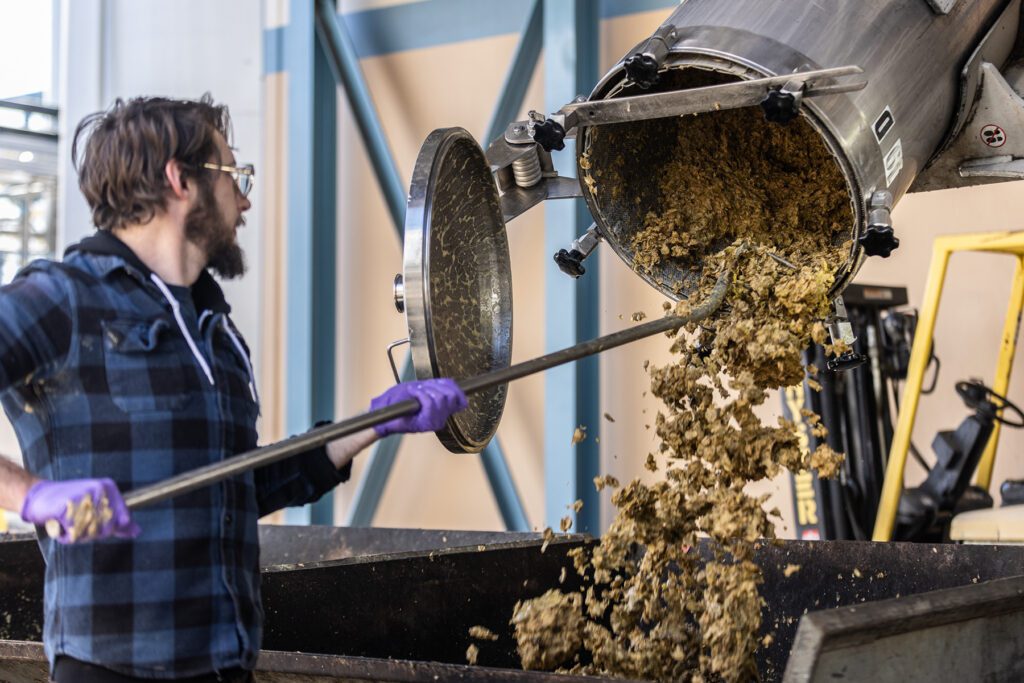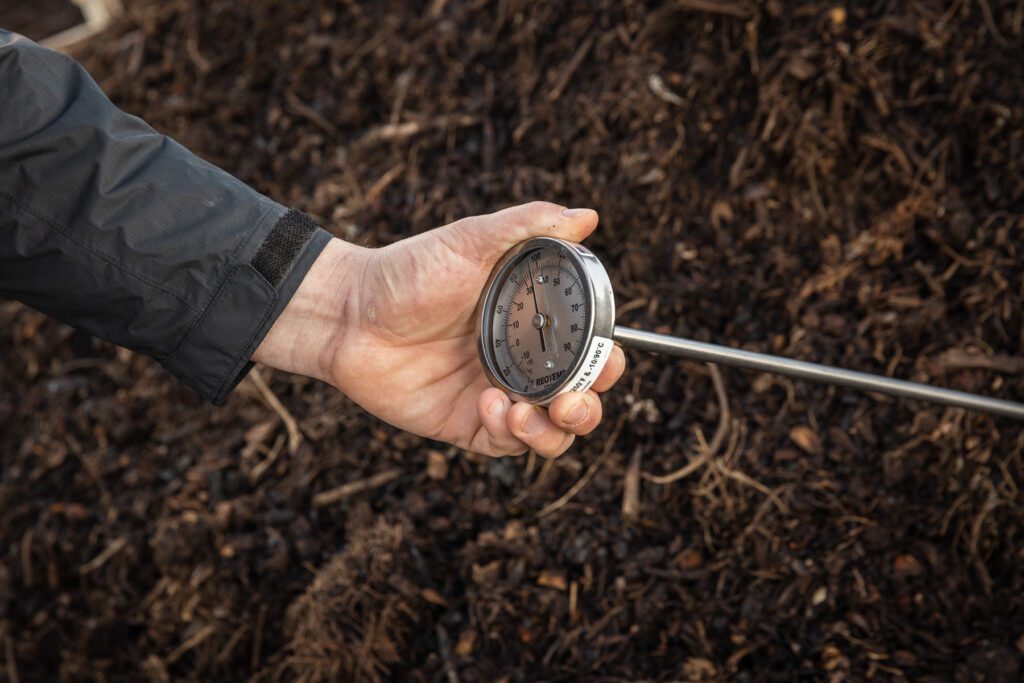Ryan Faris pulls out his phone, excited to show a picture he took at dawn when his shift started.
But it’s not the radiant sunrise you might expect. Instead, it’s the billowing steam rising from a giant pile of thermal compost — a toasty mound on a chilly morning. Buried inside are wood chips, almond hulls, and thousands of pounds of spent brewing ingredients, like heaps of hops that once filled our Hop Torpedoes.


Since early 2022, Ryan and our Chico agriculture team have worked to expand our on-site composting efforts, which started in 2010 with the installation of our pioneering HotRot system. It’s a real workhorse, creating compost at warp speed, yet it’s just one of many sustainability tools that help us achieve TRUE zero waste — we’re diverting 99.8% of solid waste from landfill.
But while the HotRot’s output is impressive — 285,738 pounds last year — Ryan is laser focused on compost quality and overall soil health. His education and career, after all, are centered around soil microbiology.


“One of the differences between [this new compost] and the HotRot is the HotRot is all done mechanically,” Ryan explains, “and checking it out it under the microscope…it’s not very diverse in the microbes that are present.”
Fostering the full spectrum of microbes is more viable when you compost manually. Still, the HotRot compost does have essential uses. We grow 25 acres of barley and rotational crops in Chico, which is a lot of land to cover. Even if a given HotRot batch trends high in salinity, for example, “our barley can handle that saltiness because barley is so adaptable,” Ryan says. “It’s kind of in our favor on that one.”



Over in our two-acre Estate garden, though, what’s in the ground is more delicate, more vulnerable. At last count, it’s home to more than 185 varieties of plant life, from flowers and fruit trees to lots of produce for our Taproom & Restaurant. Everything is certified organic, and Ryan is eager to use compost to help make it all, in essence, self-sufficient.


Wholesome compost, and the resulting hearty soil, can “give [a plant] the ability to stock its own fridge instead of force-feeding it,” he says.
It all starts with compost’s raw inputs, “because diversity in organisms comes from diversity in ingredients,” Ryan says.
And a central ingredient in this newfound effort? Huge volumes of brewing waste, most notably hops, previously destined for outside waste removal.



“We’ve gotten a lot bigger in the last 12 years” since we installed the HotRot, says Ashley Koller, our Chico sustainability program manager. “[It] can’t actually handle the volume of material that we generate anymore. … So that’s where this compost program comes into play.”
Ashley says we had been sending a 20-yard dumpster of organic waste to an off-site facility at least once a week. That tonnage has since dropped by nearly 40 percent.
“It was just a waste stream,” she says. “We’re paying money to get it sent out. It’s not like other recycling streams where we can make money on it like spent grain,” which cattle and dairy farms will use for livestock feed. “So Ryan wanted to help us reduce that cost, but also then ladder up to a waste goal.”
Going into 2022, Ryan and the Chico agriculture team set a goal to put 25,000 pounds of brewing waste toward compost — at the time an ambitious target in their minds. By the end of the year, the final math dwarfed it: 100,725 pounds of brewing waste contributed to a bounty of premiere compost — fully meeting the needs of our Estate garden and then some.


There are plenty more compost inputs, mind you, from Taproom food scraps to landscape cuttings and seasonal leaves “because you need to have a good carbon-to-nitrogen ratio,” Ryan explains. “That’s what helps good decomposition happen.”
That entire decomposition cycle, at the end of which you have usable compost, takes about 3–4 weeks, which includes a cooling period. (Applying hot compost can harm plants.) Ryan frequently “flips” the compost and takes temperature readings — requirements established by the United States Department of Agriculture.
“The rules are that it has to stay above 131 degrees Fahrenheit for three days [at a time] with a minimum of five flips because it’s not composting on the outside,” Ryan says. “So we gotta get the outside to the inside where that composting activity happens. Also…because it’s so hot, it cooks out disease and sterilizes weed seed.”


There used to be “weeding Wednesdays” for the team, Ryan says, but the compost has drastically curbed the need. “We don’t have to break our backs pulling Johnson grass over and over.”
Gripping a handful of fresh carrots, Estate garden technician Jordan Wiley says, “We’ve seen increased yields, used less irrigation, and our soil just keeps getting better.”

Ryan digs his hands into the earth nearby to show how it’s thriving.
“Oh yeah, here you go,” he says, giddily holding up a clump. “So that’s fungal hyphae forming, all the white strands. So that’s like the body of a mushroom, and you see how it’s creating bigger macro-aggregate structure.”
That fungi, Ryan explains, along with various bacteria, attracts other organisms like nematodes (read: worms), microarthropods (e.g., mites), and protozoa (e.g., amoeba) — all of which chow down on fungi and bacteria, then excrete premium plant nutrients right next to the roots.


“So it’s just like an ecosystem that we can see,” he says, zooming out for comparison. “If you have your plant: the cow eats the plant, and then the predator eats the cow [and so on] but this is all in like grams of soil having trillions of organisms in there.”
The soil is alive, and it’s serving up a nutritious buffet.
“The plant communicates with those organisms through the compounds that it makes through photosynthesis,” Ryan says. “So it’s choosing what organism it wants to culture to favor it, to get what it wants.”
Said another way, the plant requests its favorite, most beneficial snacks every time.
It’s rather fascinating, yet it’s not exactly novel; Ryan just points to nature. “How does a forest get so big without needing fertilizer?”


At our brewery in Mills River, North Carolina, the agriculture team is on the same page. In fact, they’ve been doing their own thermal composting since 2015, nourishing our half-acre Kitchen Garden and, well, everything on the property.
“You’ll see it in almost all landscaping around the entire facility,” says Pierce Schwalb, our Mills River sustainability program manager.
Their compost process, however, isn’t totally identical. While Chico has ample room, space is at a premium in Mills River, so they can’t take much brewing or food waste. (Those things still become livestock feed and compost, respectively, through our partnerships with Wilbur-Ellis and Atlas Organics.) But they have other inputs that make all the difference, like vermicompost.
“We have a worm bin filled with very high-quality, concentrated compost,” says Pierce, “which is used to inoculate the large compost pile with microorganisms.”
And just like Ryan Faris in Chico can dig into the dirt to prove Look, it’s working, Pierce says the evidence in Mills River is obvious too.
“We sample our soil on-site regularly to track biome health,” he says, “and we’ve seen exponential growth in beneficial microbes.”


So when it’s time to harvest those homegrown crops, and we design them into our Taproom menus — whether you visit Chico or Mills River — you can expect a meal that’s first-rate, from the farming to the flavor.
And the beer you’ll sip with dinner? It owes a lot to hops, but their job isn’t done, at least in Chico. Ryan will be up at sunrise soon, mixing them into the next round of compost.




